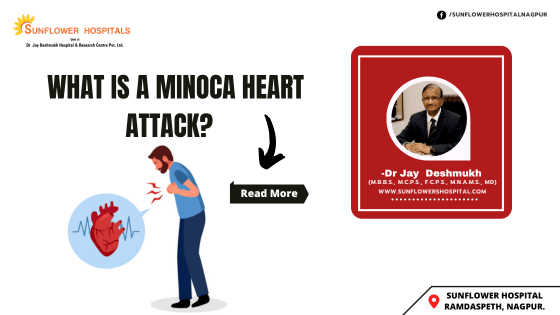What does MINOCA stand for?
MINOCA stands for Myocardial Infarction with nonobstructive coronary arteries, Thus it refers to a heart attack that occurs without any significant blockage in the arteries. Research suggests that 6-14 % of heart attacks occur without obstruction in the arteries. To diagnose this condition, the plaque in the blood vessel must block less than 50% of the arteries. MINOCA and heart attacks that result from blocked arteries tend to be similar, however, their underlying cause and who they affect can differ.
What are the different types or causes of MINOCA?
Coronary artery dissection, that is tear in the walls of the artery, coronary artery spasm also known as vasospastic angina, microvascular disease of the coronary arteries, stress cardio-myopathy also known as broken heart syndrome, inflammation of the heart muscles caused by infections, drugs, and autoimmune conditions are the common causes.
Is it less serious than a heart attack with obstruction in coronary arteries?
Unfortunately, it is as serious as obstructive coronary artery disease. It can be life-threatening and requires immediate medical attention. It presents with typical symptoms of heart attack and raised troponin T levels in the blood. A coronary angiogram, ultrasound of the coronary arteries, and tomography of the coronary arteries are necessary for A heart attack that occurs due to loss of blood supply to a part of the heart. It usually happens due to a blockage in an artery supplying blood to the heart. When a person has a heart attack that is not due to a significant blockage in an artery, it is referred to as MINOCA. Diagnosis. These are done during angiography.
Who generally gets MINOCA?
It affects women more than men. It affects younger women more than the older ones. The overall death rate within 12 months of symptoms is 4% with MINOCA versus about 6% with obstructive coronary artery disease. MINOCA is known to occur in 10% of all heart attacks. The causes are very varied in nature and thus it is considered as a working diagnosis to begin with in most cases.
Is there a role of Cardiac MRI in diagnosis?
MINOCA-like presentations can occur in myocarditis, Takotsubu, and other forms of cardiomyopathy. However, this facility is not available across India. A cardiac MRI shows different parts of the heart. It shows how blood moves and how the different parts of the heart are functioning. However, a Cardiac MRI has an immense role to play in this condition.
How is the patient treated?
This being a very heterogeneous condition, the treatment is tailored as per an individual case. This view is important, particularly in those without atherosclerosis. However, statins, blood thinners, beta-blockers, and ACE inhibitors are the mainstay of treatment.
Why is it significant to know about this condition?
Generally, after a heart attack if a coronary angiogram is not showing significant obstruction unfortunately a less methodical and milder approach to treatment is considered. It is necessary to go through all tests to find out the cause of this condition and prevent recurrences, as the next episode can be more life-threatening.
What is the clinical perspective of MINORCA?
This is usually a diagnosis that requires further investigation after coronary angiography. Intra-coronary imaging and other physiological studies are significant. Tests for blood vessel spasms and plaque disruption are considered. This is not a benign dis-ease. Treatment of the underlying cause is significant. Still, a lot of research is required to unmask the investigations and treatment of this not uncommon but unusual condition. This condition still remains an enigma. There is an immense need for well-powered, randomized controlled trials for the treatment of MINOCA.

